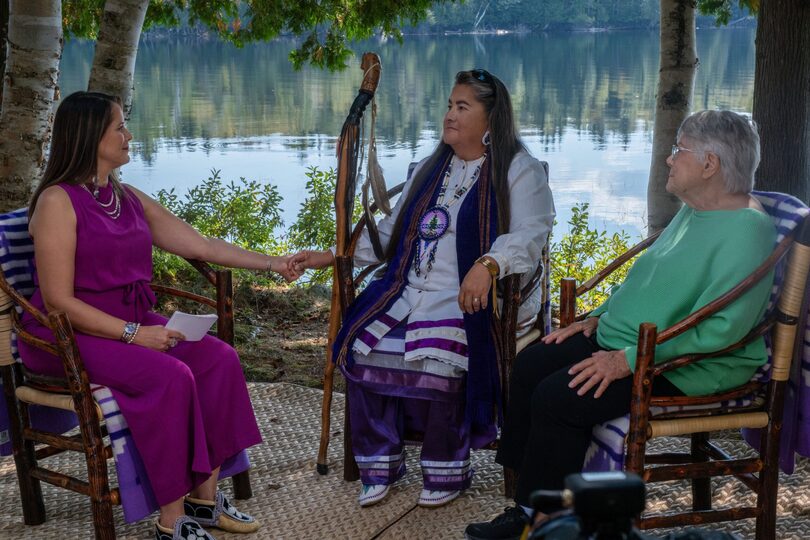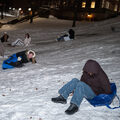Women-led Haudenosaunee nonprofit launches ‘empowering’ local talk show

The team behind “Rematriated Voices with Michelle Schenandoah” gathered at SU’s Minnowbrook Conference Center to record five group interviews. SU organizations like Orange Television Network came together to make the filming possible. Courtesy of Adriano Kalin
Get the latest Syracuse news delivered right to your inbox.
Subscribe to our newsletter here.
UPDATE: This story was updated at 6:05 p.m. EST on Thursday, Oct. 16, 2025.
CORRECTION: A previous version of this article misspelled Beverley Jacob’s first name. The Daily Orange regrets this error.
It was one of the last weekends of summer and the sun was reflecting off Blue Mountain Lake. Six women, old and young, stepped into kayaks and set out for a small island. After they rowed their kayaks ashore, the women joined in a practice of yoga while submerged in the freshwater.
“Giving thanks to the sun, giving thanks to the water, giving thanks to everyone that has made this possible — we just had a lot of gratitude,” said Michelle Schenandoah, a member of the Oneida Nation Wolf Clan. “There was this moment where we all acknowledged how that space encapsulated the practice of rematriation through centering the health of our women.”
Schenandoah is the founder of Rematriation, an Indigenous women-led nonprofit dedicated to supporting the movement of rematriation — the returning of the sacred to the Mother — across Turtle Island through uplifting Indigenous women’s voices.
On Monday, Rematriation premiered its nationwide five-episode talk show series, “Rematriated Voices with Michelle Schenandoah,” on WCNY, a collaboration with Syracuse University Libraries’ Special Collections Research Center.
The series features 11 guests, including Onondaga Hawk Clan Chief Spencer Lyons, Potawatomi botanist and New York Times best-selling author Robin Wall Kimmerer and the late women’s suffrage historian Sally Roesch Wagner.
The talk show centers on the knowledge of Haudenosaunee women and elders, seeking to educate through their lived experiences and traditional knowledge. The show will be released throughout Native American Heritage Month in November, with new episodes every week.
In addition to the launch with WCNY, the show will be released in the coming months as an extended podcast series.
The Rematriation team gathered in mid-September 2024 to film the talk show on Blue Mountain Lake at SU’s Minnowbrook Conference Center. Collaborators from the College of Visual and Performing Arts, the Newhouse School of Public Communications and Orange Television Network, members of SU Libraries’ Sound Beat: Access Audio team and Haudenosaunee consultants joined the team, along with 10 Newhouse students.
Over the course of the weekend, the group filmed five group interviews, including notable Haudenosaunee Confederacy leaders, community members and allies. Hour-long episodes centered on Haudenosaunee cosmology, history, governance and contemporary perspectives.

The vision for “Rematriated Voices with Michelle Schenandoah” was initially a podcast modeled after a past SU Libraries project. Schenandoah wanted to push the project to the next level by including a video aspect. Courtesy of Adriano Kalin
“Being in the Adirondacks on traditional territory was just empowering,” said Beverley Jacobs, a Mohawk Nation attorney who was featured in the series’ first episode. “It wasn’t just the energy of the people, but the energy of the environment. Just being in that space was really powerful.”
The rematriation movement, Schenandoah said, has its roots in Indigenous midwifery. When Haudenosaunee children are born, the family buries the placenta and the umbilical cord in the land where their people are from. They’re simultaneously creating a spiritual rootedness to the land and returning life to the Mother.
“Mother as in Mother Earth, mother tongue, mother seeds, mother nation and mother, as in our mothers. What rematriation really is, is centering life,” Schenandoah said.
Katsi Cook, member of the Mohawk Wolf Clan and an Indigenous midwife, introduced the idea of rematriation to modern-day Haudenosaunee communities. Through her activism, Mohawk Bear Clan Mother “Mommabear” Louise McDonald Herne began to see the return of stolen, culturally-significant items to the Haudenosaunee as an act of rematriation.
Many refer to this action as “repatriation,” but as matrilineal people, Haudenosaunee women like McDonald Herne recognized that as the items were returned, they were coming back to the Mother.
The stealing and appropriation of Native remains and sacred items is emblematic of U.S. colonial history and the erasure of Indigenous peoples, Schenandoah said. This erasure often starts with education.
Schenandoah recalled being in seventh-grade history class and wielding a “two-inch thick” U.S. history textbook. When she saw the Native American history section, she was excited that her classmates would get to learn about her history. What she found was one page — filled front and back — with black and white photos, not mentioning the Haudenosaunee by name once.
For Schenandoah, that experience of erasure is an inspiration for Rematriation’s work. Jacobs, who is well known internationally for her work in Indigenous human rights and law, echoes this sentiment.
“Everything that I do is about education,” Jacobs said. “Our history wasn’t taught in schools, nothing about who we are, about treaties, about relationships with each other. The intention was to erase us as a people.”
Rematration’s goal is to keep telling these stories. That’s exactly what “Rematriated Voices” does, Schenandoah said.
A talk show has been a vision of Schenandoah’s for “quite some time,” and putting it together took around three years. The first idea for the collaboration with SU was a podcast following the format of SU Libraries’ “The Land You’re On: Acknowledging the Haudenosaunee.” Rematriation is constantly thinking about how to push its work to the next level, Schenandoah said.
“We felt truly humbled and honored to sit with our leaders, hear from our elders and talk with them,” Schenandoah said. “I would love for other people to sit and listen and hear from them too. I am confident they will feel that impression upon their souls.”

“Rematriated Voices with Michelle Schenandoah” centers the knowledge of Haudenosaunee women and elders. Before filming for the talk show even started, people working on the project gained a deeper knowledge of Haudenosaunee values. Courtesy of Adriano Kalin
One of the organization’s goals is to connect Western society with the values and knowledge of Indigenous teachings that’ve sustained their peoples for millennia, she said.
Many people today are feeling lost, Schenandoah said, and she believes Haudenosaunee values about living in peace, nurturing one’s gifts as a human being and living in balance with the natural world can help people to feel more fulfilled.
“When people begin to understand that we are all equal to, and no greater than, the trees and the water and the air and the birds, then comes the greater understanding that we are all a part of the natural world, not separate from it,” she said.
Instilling a deeper knowledge of Haudenosaunee values in non-native students and production members happened before starting to film the talk show.
Sophia Moore graduated from Newhouse last year with a degree in television, radio and film. During her senior year, she was invited by OTN General Manager Meg Craig to be a production assistant on-set at Minnowbrook.
“It was such a prime opportunity for me to just sit back and listen, really letting what they were talking about resonate with me and color the way I see the world,” Moore said.
SU SCRC Access Audio producer Jim O’Connor also helped to produce the “Rematriated Voices” series. O’Connor first met Schenandoah while creating the podcast, “The Land You’re On: Acknowledging the Haudenosaunee.”
Because of his background at SCRC, O’Connor came into the project with a desire to document everything.
“In storytelling, I love that ideation phase where all of these passionate people gather together and talk about what something could be at the end of it,” O’Connor said. “And to now stand at this phase of it is really gratifying. It involved a million people’s hard work, and I’m really excited to finally share that.”
As the Rematriation team looks to the future and the possibility of a second series, the team is also taking time to revel in the sense of pride and accomplishment, Schenandoah said.
“Mommabear is here to say,” McDonald Herne said in the series premiere, pausing and looking over her shoulder to fellow Haudenosaunee women. “It’s time. The mother is back in the house.”






